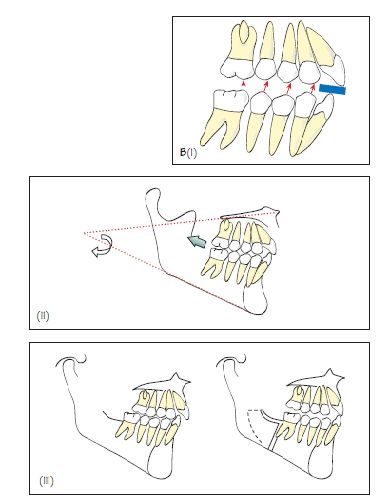27
Deep bite malocclusion
Table 27.1 Akerly classification of traumatic overbite.
| Akerly 1 | The lower incisors occlude with the palatal mucosa causing mucosal trauma away from the patatal gingival margin |  |
| Akerly 2 | The lower incisors occlude with and traumatise the palatal gingival margins of the upper incisors |  |
| Akerly 3 | Traumatic occlusion leads to stripping of the lower labial and the upper palatal gingivae |  |
| Akerly 4 | The incisors sheer past each other causing wear on the palatal aspects of the upper incisors and sometimes the labial aspect of the lower incisors. This may be associated with loss of posterior dental support and/or a parafunctional habit |  |
Table 27.2 Methods for reducing a deep overbite.
| Technique | |
| Removable appliance | • Anterior bite plane • Headgear • Functional appliances |
| Fixed appliance | • Fixed orthodontic appliances |
| Orthognathic surgery | • Mandibular advancement • Lower labial segment setdown |
| Resorative treatment | • Restoration of the posterior occlusal vertical dimension • Occlusal splints • Dahl appliance |
Figure 27.1 (A) Classification of overbite. (B) Methods for reducing a deep overbite. (i) An anterior bite plane encourages molar eruption and prevents incisor eruption, (ii) Distal movement of the maxillary molars results in bite opening by the wedge effect, (iii) In non-growing individuals with Class II deep bite malocclusion, anterior-inferior surgical repositioning of the mandible can reduce the OB and increase the LAFH.


The overbite (OB) is the vertical overlap of the mandibular incisors by the maxillary incisor/>
Stay updated, free dental videos. Join our Telegram channel

VIDEdental - Online dental courses


